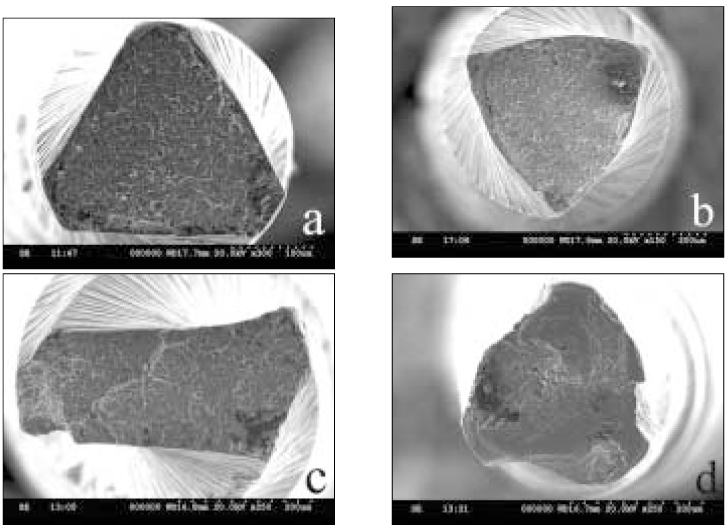J Korean Acad Conserv Dent.
2005 May;30(3):184-192. 10.5395/JKACD.2005.30.3.184.
Lifetime and fracture patterns of NiTi rotary files in molars
- Affiliations
-
- 1Department of Conservative Dentistry, College of Dentistry, Kangnung National University, Korea. mendo7@kangnung.ac.kr
- KMID: 2045244
- DOI: http://doi.org/10.5395/JKACD.2005.30.3.184
Abstract
- Intracanal separation of the rotary files is a serious concern in modern endodontic practice. The objective of this study was to compare the life span and fracture patterns of three NiTi rotary files in molar teeth. Mesiobuccal roots of upper molar (n = 150) and mesial roots of lower molar (n = 150) were divided into three groups and each group was prepared with Profile, ProTaper, and K3 respectively. Every file was used until separation and/or deterioration of the cutting blade was happened, and then the number of canals to separation and/or unwinding were recorded. Radiographs and Scanning electon microscope (SEM) photographs were taken to evaluate the patterns of separation. The results were as follows : 1. There were no significant differences in numbers of canals to separation and/or unwinding among the groups. 2. Comparing between flaring files, K3 showed significant lower numbers of canals to separation and/or unwinding (p < 0.05), and there was no significant difference between shaping files 3. Separations of instruments were occurred at the midpoint of curvatures within the canals. 4. In SEM observations, ductile fractures were seen in most of cases, characterized by shallow dimples. Additional researches is needed to provide a new guideline that informs the appropriate number of times to use NiTi files.
Keyword
Figure
Cited by 1 articles
-
An evaluation of rotational stability in endodontic electronic motors
Se-Hee Park, Hyun-Woo Seo, Chan-Ui Hong
J Korean Acad Conserv Dent. 2010;35(4):246-256. doi: 10.5395/JKACD.2010.35.4.246.
Reference
-
1. Schilder H. Cleaning and shaping the root canal. Dent Clin North Am. 1974. 18:269–296.2. Skidmore AE, Bjorndal AM. Root canal morphology of the human mandibular first molar. Oral Surg Oral Med Oral Pathol. 1971. 32:778–784.
Article3. Weine F, Kelly R, Lio P. The effect of preparation procedures on the original canal shape and on apical foramen shape. J Endod. 1975. 1:255–262.
Article4. Walia H, Brantely WA, Gerstein H. An initial investigation of the bending and torsional properties of nitinol root canal files. J Endod. 1988. 14:346–351.
Article5. Glossen CR, Haller RH, Dove SB, del Rio CE. A comparison of root canal preparations using Ni-Ti hand, Ni-Ti engine-driven, and K-Flex endodontic instruments. J Endod. 1995. 21:146–151.
Article6. Serene TP, Adams JD, Saxena A. Nickel-titanium instruments: applications in endodontics. 1995. St. Louis: Mosby;67–78.7. Barbakow F, Lutz F. The "Lightspeed" preparation technique evaluated by Swiss clinicians after attending continuing education courses. Int Endod J. 1997. 30:46–50.
Article8. Zuolo ML, Walton RE. Instrument deterioration with usage: Nickel-Titanium versus stainless steel. Quintessence Int. 1997. 28:397–402.9. Mandel E, Adib-Yazdi M, Benhamou LM, Lachkar T, Mesgouez , Sobel M. Rotary Ni-Ti profile systems for preparing curved canals in resin blocks: influence of operator on instrument breakage. Int Endod J. 1999. 32:436–443.
Article10. Ruddle C. Cleaning and shaping the root canal system. Pathways of the Pulp. 2002. 8th ed. Mosby: St. Louis;231–292.11. Sattapan B, Nervo GJ, Palamara JEA, Messer HH. Defect in rotary nickel-titanium files after clinical use. J Endod. 2000. 26:161–165.12. Haikel Y, Serfaty R, Bateman G, Senger B, Allemann C. Dynamic and cyclic fatigue of engine-driven rotary nickel-titanium endodontic instrument. J Endod. 1999. 25:434–440.13. Gambarini G. Cyclic fatigue of Profile rotary instruments after prolonged clinical use. Int Endod J. 2001. 34:386–389.
Article14. Pruett JP, Clement DJ, Carnes DL Jr. Cyclic fatigue testing of nickel-titanium endodontic instruments. J Endod. 1997. 23:77–85.
Article15. Gary C. Influence of material properties on the rotational speed of engine-driven nickel-titanium instrument. Contemporary Endod. 2002. 28–30.16. Mize SB, Clement DJ, Carnes DL, Pruett JP. Effect of sterilization on cyclic fatigue of Ni-Ti instruments. Abstracts of research. AAE 54th session. J Endod. 1997. 23(OR9):251.17. Yared GM, Bou Dagher FE, Machtou P. Cyclic fatigue of Profile rotary instruments after clinical use. Int Endod J. 2000. 33:204–207.
Article18. Peters OA, Barbakow F. Dynamic torque and apical forced of ProFile .04 rotary instruments during preparation of curved canals. Int Endod J. 2002. 35:379–389.
Article19. Booth JR, Sheetz JP, Lemons JE, Eleazer PD. A comparison of torque reqiured to fracture three different nickel-titanium rotary instruments around curves of the same angle but of different radius when bound at the tip. J Endod. 2003. 29:55–57.
Article20. Gambarini G. Cyclic fatique of nickel-titanium rotary instruments after clinical use with low- and high torque endodontic motors. J Endod. 2001. 27:772–774.
Article21. Cho JC, et al. Metal Failure Analysis. 2002. Seoul: Jinyoungsa;15–41.22. Lee DR. Mechanical Metallurgy. 1985. Seoul: Moonundang;219–291.23. Zinelis S, Margelos J. Eliades G, Eliades T, Brantley W, Watt DC, editors. Aging of endodontic instruments and materials. Dental materials in vivo: aging and related phenomena. Carol Stream. 2003. Carol Stream: Quintessence Publishing Co Inc;180–186.
- Full Text Links
- Actions
-
Cited
- CITED
-
- Close
- Share
- Similar articles
-
- Effect of surface defects and cross-sectional configuration on the fatigue fracture of NiTi rotary files under cyclic loading
- Mechanical and geometric features of endodontic instruments and its clinical effect
- A survey of experience-based preference of Nickel-Titanium rotary files and incidence of fracture among general dentists
- Comparative study on morphology of cross-section and cyclic fatigue test with different rotary NiTi files and handling methods
- Comparison of the cyclic fatigue resistance of VDW.ROTATE, TruNatomy, 2Shape, and HyFlex CM nickel-titanium rotary files at body temperature



